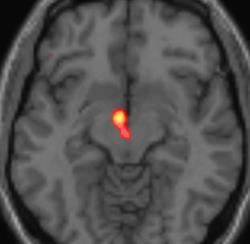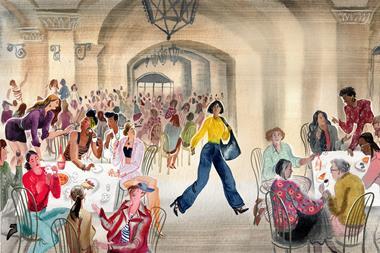Scientists are beginning to make sense of romantic love through modern imaging techniques and a multidisciplinary approach. Michael Gross uncovers the method behind the madness
Cupid, the mischievous little archer, may be all around us at this time of the year, but there is little scientific evidence to support the age-old claim that his arrows make people fall in love. Plato’s beautiful explanation involving the loss of an ’other half’ wouldn’t withstand today’s peer review either. And if anybody tries to sell you a love potion à la Tristan and Isolde, you should not expect any miracles from it.
The romantic phenomenon persists, and according to Helen Fisher, an anthropologist at Rutgers University, US, it is a universal or near-universal cultural constant. There is no human culture on Earth, she claims, that has been proven not to know the phenomenon of romantic love.
If it is universal, scientists argue, there must be a biological basis for it. In other words, it cannot be simply a cultural tradition like cricket or opera. In recent years, some researchers have boldly forsaken their natural fear of the irrational side of human beings and set out to investigate the biological and chemical processes underlying romantic love. In particular, they have studied the action of genes, neurons, and chemical messengers such as hormones and pheromones.
The vole story
Naturally, if some kind of biological phenomenon is universally found throughout a species, one would expect it to be ingrained in the genes in some form or shape. The trouble with love is that it is a complex phenomenon, presumably controlled by complex interactions between many different gene products. Thus, it would be difficult to study for the same reasons that apply to multifactorial diseases such as heart disease. Furthermore, the trouble with human subjects is that ethical concerns rule out genetic manipulation, which would be required to deconvolute the interactions of many genes.
Therefore, genetic studies of mating and courtship have so far remained limited to animals and to relatively simple questions. The most spectacular and widely reported study of this type was conducted with two species of North American voles, namely the monogamous prairie voles (Microtus ochrogaster), and the genetically related montane voles (Microtus montanus), which do not form any bonds but copulate at random. Researchers Thomas Insel and Larry Young at Emory University in Atlanta, Georgia, US, discovered an insertion in a gene of the monogamous prairie vole which is suspiciously absent in the polygamous montane vole.
The researchers incorporated the gene with the insert in the genomes of male montane voles. This simple genetic manipulation succeeded in ’curing’ these rodents of their promiscuity.
More recently, another sex gene has been tracked down in the fruit fly Drosophila. Ken-Ichi Kimura and co-workers at Hokkaido University, Japan, demonstrated that the protein encoded by the fruitless gene of Drosophila controls the construction of a male-specific neural circuit which is thought to play a key role in male courtship behaviour. Which neatly shifts our attention from genes to neurons and the brain.
Truly madly deeply
Modern brain imaging techniques such as functional magnetic resonance imaging (fMRI) or magneto-encephalographic (MEG) scanning have opened up a whole new world of possibilities because they enable researchers to observe the working brain without harming the patient.
Helen Fisher joined forces with US researchers Arthur Aron from the State University of New York at Stony Brook and Lucy Brown from the Albert Einstein College of Medicine in New York to investigate the neural manifestations of early-stage romantic love. Essentially, they set out to establish whether love works like a fundamental emotion such as fear or whether it is produced by the feedback loops of the brain’s reward system in a similar way to cocaine addiction.

The researchers recruited 10 women and seven men who claimed to have been intensely in love for between one and 17 months, and assessed them by interviews before and after the fMRI study. During the imaging experiment, each participant was shown a photo of their romantic partner and asked to recall any cherished memories linked to that person. As negative controls, they were also shown photos of other friends and family members and asked the same question.
To purge any romantic feelings, the subjects were made to count backwards from a randomly selected four-digit number in steps of seven. (Try this procedure if you ever need to clear your brain of romantic overload - it seems to have been efficient within less than a minute.)
By comparing the scans the researchers were able to pin down several key regions of the brain that appear to be involved in intense romantic feelings but not, for example, in face recognition. Specifically, they recorded activation of the right ventral midbrain, around the so-called ventral tegmental area (VTA) and the dorsal caudate body and caudate tail. All of these regions are unrelated to primeval instincts and emotions such as fear, but they are linked to the reward system that can get us addicted to drugs.
Reviewing their work in comparison with related papers, Fisher, Aron and Brown conclude that ’romantic love is primarily a reward system, which leads to various emotions, rather than a specific emotion’. Characteristically, there is no facial expression that can be unequivocally linked to being in love. They also observe that early stage, intense romantic love is different from both the sex drive and the development of attachment in the later phases of a relationship, which activate different areas of the brain.
In a follow-up study, Fisher and her colleagues have started to look at what happens when love goes wrong. ’We all get dumped at one point or another,’ Fisher says, ’so I wanted to see what happens in the brain when you are rejected in love.’
She and her colleagues applied the brain imaging technology to a group of 15 volunteers whose partners had recently left them. From the preliminary results, Fisher concludes that ’a lot happens in the brain when you look at a photo of someone who has just abandoned you, including activity in brain regions associated with physical pain, obsessive-compulsive behaviours, controlling anger, and regions that we use when we are trying to speculate on what someone else is thinking’. Far from switching off the brain activities involved in the previous romantic bliss, Fisher finds that ’it also appears that when you get dumped you start to love your rejecting partner even harder’.
A key feature of the brain areas that the US researchers have connected to romantic love is that they are involved in signalling pathways using the hormone and neurotransmitter dopamine. But which other hormones can be blamed for the emotional rollercoasters of romantic love?
Molecules in love
Donatella Marazziti, a psychiatrist at the University of Pisa, Italy, started out investigating the hormonal changes connected to obsessive-compulsive disorder, before moving on to those that occur when people fall in love. Initially, she and her co-workers found a decrease in functionality of serotonin transporters in the blood of enamoured volunteers, who had been selected and rated on a passionate love scale (PLS), much like those in the US studies. Like obsessive-compulsive patients, the love-struck volunteers showed a reduced concentration of serotonin in the blood, which might explain why early phase romantic love can turn into obsession.
In her most recent study, Marazitti, together with fellow Pisa researcher Domenico Canale, casts the net wider to check for changes in the concentration of a number of hormones, including oestradiol, progesterone, dehydroepiandrosterone, and androstenedione, which were found to be unaffected by any romantic feelings. In contrast, they observed changes for cortisol, follicle stimulating hormone, and testosterone. Some effects were gender-specific. For example, testosterone was found to increase in love-struck women but to reduce in men when they are in love.
If lovers swear their feelings to be everlasting, the hormones clearly tell a different story. Re-testing the same subjects 12-24 months later, Marazziti and Canale found that the hormonal differences had disappeared entirely, even if the relationships remained intact.
Using the same method for volunteer selection, Enzo Emanuele and his co-workers at the University of Pavia, Italy, investigated whether a different class of chemical messengers, the neurotrophins, is involved in the romantic experience. At the end of 2005 they reported that the concentration of nerve growth factor (NGF) in the blood exceeds normal levels in enamoured volunteers, and that it increases with the intensity of romantic feelings as measured by the PLS. Whether more NGF is needed in early stage romance because of all the new experiences that are engraved into the brain, or whether it has a second, as yet unknown, function in the chemistry of love remains to be explored.
Emanuele and co-workers also found that after one to two years, all of the love molecules had gone, even if the relationship survived. Neither the initial intensity of the PLS nor the concentration of NGF appeared to be a suitable predictor for the fate of the relationship after that period.
But, if all the chemical messengers of intensive romantic feelings disappear within two years, what is the chemical glue that keeps - at least some - couples together?
Hormonal attachment
A key molecule for the attachment phase is the hormone oxytocin, a nonapeptide that was first described as the chemical that induces labour and lactation, but later found a second job as the human ’cuddle hormone’. It is related to the hormone vasopressin, which controls kidney function, and has also been identified when prairie voles form attachments.
Experiments have shown that, depending on the species, either or both of these hormones can make animals snuggle up. In humans, it has been shown that oxytocin production is high during female orgasm. Apart from that, and its role in childbirth, very little was known about oxytocin’s role in human physiology and psychology until recently.
Last year, several groups reported progress in investigating oxytocin’s role in humans, linking the hormone to early socialisation, social cognition, and trust. Michael Kosfeld and his co-workers at the University of Zurich, Switzerland, showed that applying oxytocin via a nasal spray made participants in a trust game more trusting towards other human participants, but not towards a computer. This finding fits in with the expectations of the Italian researchers. ’I am not surprised by the results of Kosfeld’s paper,’ says Donatella Marazziti, who has just completed a study of oxytocin in romantic love but keeps the details under wraps.
Cupid’s arrows
Finally, another family of chemical messengers associated with love, the pheromones, are equally poorly understood in humans, as most of our knowledge derives from animals. By definition, pheromones are chemicals intended for communication between individuals of the same species. Their use in insects is well understood to the extent that pheromone traps are commercially available for crop protection.
Our knowledge is much more incomplete for mammals, let alone humans. Most people’s educated guess is that pheromones secreted from some glands, eg with sweat, are recognised by receptors presumably located in a very small part of our nose known as Jacobson’s organ or vomero-nasal organ (VNO). However, it was only in 2002 that researchers could pin down some putative mammalian pheromone receptors in mice.
Last October, Hiroko Kimoto’s group at the University of Tokyo, Japan, added a surprising piece to the jigsaw. The researchers showed that a non-volatile mouse pheromone, which they called ESP-1 (exocrine-gland secreting peptide) is released from the tear glands of the male mouse and, after face to face contact, activates receptors in the female’s VNO.
Again, it remains unclear whether human male tears have a similar effect on the female of the species. Indeed, there is a long-running controversy as to whether the human VNO is in fact a working part of our physiology or whether it’s an inactive relic of mammalian evolution. It now appears that the evidence is slowly giving the pro-VNO party the upper hand.
To any romantically inclined chemist, it should be deeply satisfying to be able to prove that chemical messengers communicate romantic feeling between humans. After all, this is the only thing that science can offer as a real-world analogy to Cupid’s arrows.
Additional information
-
G Froböse and R Froböse, translated by M Gross, Lust and love: is it more than chemistry?, 2006, RSC
-
H Fisher, Why we love: the nature and chemistry of romantic love, 2004, Henry Holt
-
L J Pitkow et al, J. Neurosci., 2001, 21, 7392
-
A Aron et al, J. Neurophysiol., 2005, 94, 327
-
H Fisher et al, J. Comp. Neurol., 2005, 493, 58
-
D Marazziti and D Canale, Psychoneuroendocrinol., 2004, 29, 931
-
E Emanuele et al, Psychoneuroendocrinol., 2005 (DOI: 10.1016/j.psyneuen.2005.09.002)
-
H Kimoto et al, Nature, 2005, 437, 898






No comments yet